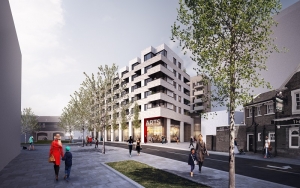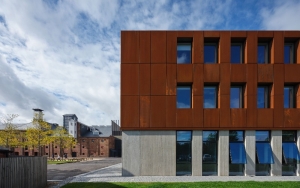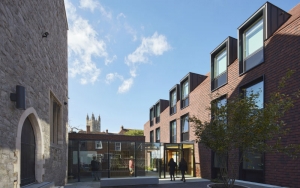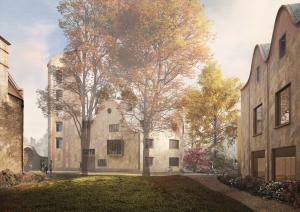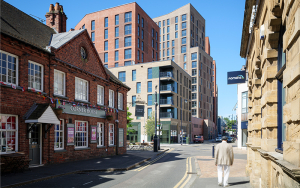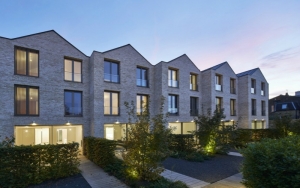Half Acre, Brentford
This project is a pair of linked schemes in Brentford, west London catering for the demolition of the former Brentford Police station and its related housing section. In place, the new site will feature the redevelopment of the Watermans Art Centre and also the creation of nearly three hundred homes.
Hill House Archway
Hill House was a 1970s, 13-storey office building, which is part of the Archway Island site in Islington, north London. The project retained the existing building and converted 12 floors to residential use, housing over 150 flats and recreational facilities.
Holy Trinity Swiss Cottage - The Lighthouse
Known as The Lighthouse, the refurbishment and expansion of Holy Trinity Church Swiss Cottage aims to develop a multi-use community beacon on north London’s busy Finchley Road.
King's School Canterbury – International College
Eco-Friendly home for international students entering UK Boarding
A three-storey, cross-laminated timber building surrounding a courtyard, designed for international students. It features 34 ensuite bedrooms for 80 students, staff flats, and teaching facilities, primarily located on the ground floor, including classrooms, music rooms, IT suites, art studios, and common rooms. Achieved BREEAM 'Very Good'.
The project is part of the school’s £48m masterplan, which includes the Malthouse performing arts centre, Kingsdown House boarding accommodation, Mitchinson’s day house, and the new Rausing Science Centre—all developed in collaboration with Skelly & Couch.
The building features a modular, square plan, surrounding a private courtyard designed for socialising and outdoor learning. Ground floor classrooms are complemented by breakout spaces that overlook the courtyard. Above, the first and second floors accommodate up to 80 students in en-suite bedrooms, with staff flats provided on both levels.
The building has been designed on passive environmental principles. Early involvement ensured the façade and fenestrations allowed for all internal spaces to be adequately daylit, and naturally ventilated, while preventing overheating. Off-site construction bathroom pods and CLT elements have been integrated, requiring a high level of early co-ordination.
The ground floor classrooms are naturally ventilated, and include a system by Windowmaster, which monitors internal temperature and CO2 levels, adjusting window openings accordingly. The same classrooms rely on architecturally exposed concrete ceilings to provide thermal mass, maintaining comfortable internal temperatures all year round, without the need for active cooling measures.
LED lighting and smart lighting controls reduce electrical energy consumption. Underfloor heating has been used throughout the ground floor, utilising low water temperatures, thus reducing the heat demand from the main heating plant.
The International School creates a welcoming and inspiring experience for young pupils arriving in the UK, whilst setting a benchmark for sustainability in boarding education. It reinforces the school’s global leadership and environmental responsibility.
Awards
RIBA National Award 2021. Find out more.
Civic Trust Awards - Highly Commended. Judges’ Comments: “Overall, there is a good sense of proportions, the chosen materials work well and the atmosphere of the place is secure and safe for the student community.”

King's School Canterbury – Mitchinson's Day House
Masterful conversion of Grade II-listed building of archaeological importance
Redevelopment of a workshop into a day house with study and social spaces, kitchenette, shower, WC’s, lockers, and facilities for the deputy house parent and matron, including a 3-bed apartment and a separate study. Achieved BREEAM ‘Very Good’.
The project is part of the school’s £48m masterplan, which includes the Malthouse performing arts centre, Kingsdown House boarding accommodation, International College and the new Rausing Science Centre—all developed in collaboration with Skelly & Couch.
The tight site within the Conservation area of Canterbury, was chosen to provide a day house for 70 non-boarding pupils across all senior school year groups. It contains the remains of a medieval hospice, which forms one external wall and is a scheduled ancient monument, with additional ruins at the west boundary and below the footprint, also protected under the same designation. Due to its historical and archaeological context, many conventional renewable technologies were deemed unacceptable, while other planning conditions required limitations on glazing, particularly on the first floor.
The building’s form reacts to these constraints by providing an abundance of daylight and fresh air through both a glazed courtyard and a number of rooflights. A thermal energy model was developed at an early stage to inform the architectural detail, thermal performance and environmental design of operational systems. The thermal model also informed the design of a number of discreet rooflight actuators, which are controlled automatically via temperature and CO2 sensors in each study space. An overheating assessment also proved that passive night cooling could be utilised through the rooflight openings to ensure the building remains comfortable throughout the summer months.
Efficient LED lighting and daylight dimming controls significantly reduce energy consumption.
Mitchinson’s Day House prioritises sustainability through passive design to reduce energy use, while providing a highly comfortable internal environment.
Shortlisted for an AJ Retrofit Award 2019 (School category).
King’s School Canterbury – Kingsdown House
Heritage-Sensitive Phased Refurbishment and New Boarding Accommodation
Phase 1 involved the restoration and refurbishment of the Butterfield Building and Master’s House to create boarding accommodation for 30 pupils, including a common room, quiet study area, and kitchen. Phase 2 introduced a new building for older pupils, achieving a BREEAM 'Very Good' rating.
Located near Canterbury Cathedral, a Scheduled Ancient Monument, the Grade II-listed Butterfield Building, designed by William Butterfield in 1847, was sensitively upgraded and connected to a new boarding house for girls. The project was successfully executed on a rapid timeline, with the facilities required to be operational by the start of the academic year.
The refurbishment included new glazing and insulation to meet modern thermal standards, while the new building featured windows designed to optimise daylight and natural ventilation while minimising heat loss. The structure uses a recyclable steel frame combined with precast concrete planks and a concrete screed to balance thermal mass and lightweight construction, enhancing thermal capacity and reducing overheating.
Drainage was upgraded to HDPE, a more environmentally friendly option compared to PVC or cast iron.
Inefficient heating and lighting systems in the listed building were replaced, significantly reducing carbon emissions, while low-energy systems were implemented in the new building. LED lighting with 'absence control' was installed throughout to ensure lights automatically turn off when not in use. The heating system features automatic central controls, allowing sections of heating and hot water to be turned off when students are absent, while maintaining warmth in staff areas.
Kingsdown House blends modern functionality with heritage sensitivity. The project achieved a BREEAM 'Very Good' environmental rating, all while avoiding intrusive 'green' add-ons that could compromise its historic character.
Awards
2018 Civic Trust Awards – commendation
2017 RIBA South East Awards – shortlisted
2018 Canterbury Society Design Awards: New Building in a Conservation Area
2018 Canterbury Society Design Awards: Refurbishment
2018 Canterbury Society Design Awards: Overall Winner
New College Court, Emmanuel College
A phased transformation of the Emmanuel College Site around three new landscaped courts.
New residential student blocks with 59 ensuite rooms, gyms, fellow flats, and a 50-space subterranean car park, plus the transformation of a Grade II listed building to provide seminar, teaching, office, bar and event spaces along with the rebuilding of the South Court Social Hub.
The project was Emmanuel College’s most significant development for over 100 years and was located in the heart of the Cambridge Historic Core Conservation Area, in close proximity to the College’s historic Grade I and Grade II listed buildings. The aim was to redevelop a neglected part of the College site to create new facilities that enabled the College to meet its ambition to accommodate all undergraduate students on-site and for its community to mix, work and gather in new ways. Skelly & Couch were appointed as both M&E engineers and sustainability consultants and undertook full design duties using BIM.
From inception, Skelly & Couch worked closely with the architects to ensure the building massing and orientation was optimised to make best use of daylight and sunlight in all internal and external spaces. The advantages and disadvantages of concrete and CLT frames were considered and GGBS concrete frame with timber internal partitions and highly insulated timber facades was chosen for its improved performance in terms of summertime overheating and acoustics.
The system design included a number of energy and water saving measures such as mechanical ventilation and heat reclaim, rainwater recycling, Combined heat and power hot water heating, efficient LED lighting and controls. The strategy also included the implementation of an open loop ground source heat pump system that takes water from the underlying Lower Greensand Formation and provides heating and cooling to all of the buildings in the South of the College. It also includes an extensive 60kWp PV array on the South Court Building.
All of these measures represented an 80% operational carbon controls, low flow water fittings and a large Photovoltaic Array on the roof that powers the communal spaces.
Driven by a vision to cultivate an interconnected community, Emmanuel College adds a contemporary layer to its historic setting while enhancing social and intellectual life and prioritising sustainability for future relevance.
Press Coverage
New College, Oxford
This competition-winning project is the provision of new student accommodation (100 bedrooms) and facilities for Gradel Quad at New College, Oxford.
One Maidenhead - The Landing - HUB Group
Large town centre regeneration scheme next to the crossrail station.
Mixed-use regeneration development in the centre of Maidenhead, comprising 429 homes, a new 5,200m² office building, car parking, 3,400m² of shops and leisure and a new public space at its heart. The project achieved BREEAM ‘Very Good’.
After the successful partnership with developer HUB on the eco-friendly project Abbey Place near Abbey Wood Crossrail Station, Skelly & Couch once again joined forces for One Maidenhead. This collaboration included environmental modelling during the planning phase, followed by client-side monitoring throughout the project.
One Maidenhead met close to Passivhaus fabric standards, with an excellent airtightness further enhanced by façades incorporating solar control in the form of deep reveals, and solar control glazing. These features contributed to low heating needs, allowing for an all-electric scheme. During winter, electric heaters provide warmth, while in summer, a Mechanical Ventilation with Heat Recovery (MVHR) system maintains comfortable indoor temperatures by drawing in fresh air from strategic openings.
A substantial portion of the project’s electrical energy is derived from its large PV array on all roofs, with excess electricity exported. Additionally, a building energy management system with full fault diagnostics was implemented alongside energy sub-metering and low-use water fittings for lower hot water consumption.
One Maidenhead emerges as a catalyst for eco-conscious developments, championing all-electric schemes to pave the way for a greener Maidenhead and beyond.
Paradise Gardens
Paradise Gardens is a multi-award-winning sheltered residential development consisting of six family homes surrounded by communal landscape gardens, at the heart of Ravenscourt Village in Hammersmith. The development transformed a former constricted, derelict yard, which is visible from all sides by neighbours, and lies within Starch Green conservation area next to Ravenscourt Park.

